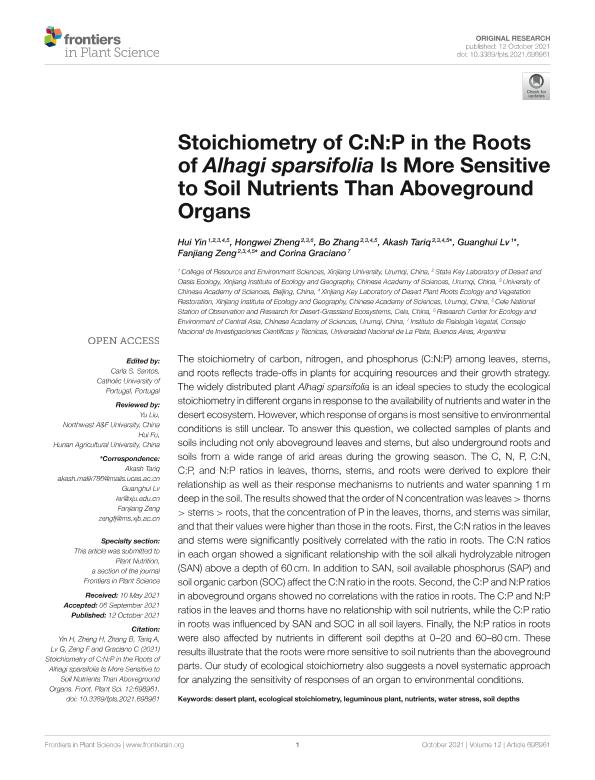Mostrar el registro sencillo del ítem
dc.contributor.author
Yin, Hui
dc.contributor.author
Zheng, Hongwei
dc.contributor.author
Zhang, Bo
dc.contributor.author
Tariq, Akash
dc.contributor.author
Lv, Guanghui
dc.contributor.author
Zeng, Fanjiang
dc.contributor.author
Graciano, Corina

dc.date.available
2022-12-15T14:12:24Z
dc.date.issued
2021-10
dc.identifier.citation
Yin, Hui; Zheng, Hongwei; Zhang, Bo; Tariq, Akash; Lv, Guanghui; et al.; Stoichiometry of C:N:P in the Roots of Alhagi sparsifolia Is More Sensitive to Soil Nutrients Than Aboveground Organs; Frontiers Media; Frontiers in Plant Science; 12; 6989; 10-2021; 1-12
dc.identifier.uri
http://hdl.handle.net/11336/181324
dc.description.abstract
The stoichiometry of carbon, nitrogen, and phosphorus (C:N:P) among leaves, stems, and roots reflects trade-offs in plants for acquiring resources and their growth strategy. The widely distributed plant Alhagi sparsifolia is an ideal species to study the ecological stoichiometry in different organs in response to the availability of nutrients and water in the desert ecosystem. However, which response of organs is most sensitive to environmental conditions is still unclear. To answer this question, we collected samples of plants and soils including not only aboveground leaves and stems, but also underground roots and soils from a wide range of arid areas during the growing season. The C, N, P, C:N, C:P, and N:P ratios in leaves, thorns, stems, and roots were derived to explore their relationship as well as their response mechanisms to nutrients and water spanning 1 m deep in the soil. The results showed that the order of N concentration was leaves > thorns > stems > roots, that the concentration of P in the leaves, thorns, and stems was similar, and that their values were higher than those in the roots. First, the C:N ratios in the leaves and stems were significantly positively correlated with the ratio in roots. The C:N ratios in each organ showed a significant relationship with the soil alkali hydrolyzable nitrogen (SAN) above a depth of 60 cm. In addition to SAN, soil available phosphorus (SAP) and soil organic carbon (SOC) affect the C:N ratio in the roots. Second, the C:P and N:P ratios in aboveground organs showed no correlations with the ratios in roots. The C:P and N:P ratios in the leaves and thorns have no relationship with soil nutrients, while the C:P ratio in roots was influenced by SAN and SOC in all soil layers. Finally, the N:P ratios in roots were also affected by nutrients in different soil depths at 0–20 and 60–80 cm. These results illustrate that the roots were more sensitive to soil nutrients than the aboveground parts. Our study of ecological stoichiometry also suggests a novel systematic approach for analyzing the sensitivity of responses of an organ to environmental conditions.
dc.format
application/pdf
dc.language.iso
eng
dc.publisher
Frontiers Media

dc.rights
info:eu-repo/semantics/openAccess
dc.rights.uri
https://creativecommons.org/licenses/by-nc-sa/2.5/ar/
dc.subject
DESERT PLANT
dc.subject
ECOLOGICAL STOICHIOMETRY
dc.subject
LEGUMINOUS PLANT
dc.subject
NUTRIENTS
dc.subject
SOIL DEPTHS
dc.subject
WATER STRESS
dc.subject.classification
Silvicultura

dc.subject.classification
Agricultura, Silvicultura y Pesca

dc.subject.classification
CIENCIAS AGRÍCOLAS

dc.title
Stoichiometry of C:N:P in the Roots of Alhagi sparsifolia Is More Sensitive to Soil Nutrients Than Aboveground Organs
dc.type
info:eu-repo/semantics/article
dc.type
info:ar-repo/semantics/artículo
dc.type
info:eu-repo/semantics/publishedVersion
dc.date.updated
2022-09-07T14:06:22Z
dc.identifier.eissn
1664-462X
dc.journal.volume
12
dc.journal.number
6989
dc.journal.pagination
1-12
dc.journal.pais
Suiza

dc.journal.ciudad
Lausanne
dc.description.fil
Fil: Yin, Hui. Xinjiang University; China. Chinese Academy of Sciences; República de China
dc.description.fil
Fil: Zheng, Hongwei. Chinese Academy of Sciences; República de China
dc.description.fil
Fil: Zhang, Bo. Chinese Academy of Sciences; República de China
dc.description.fil
Fil: Tariq, Akash. Chinese Academy of Sciences; República de China
dc.description.fil
Fil: Lv, Guanghui. Xinjiang University; China
dc.description.fil
Fil: Zeng, Fanjiang. Chinese Academy of Sciences; República de China
dc.description.fil
Fil: Graciano, Corina. Universidad Nacional de La Plata. Facultad de Ciencias Agrarias y Forestales; Argentina. Consejo Nacional de Investigaciones Científicas y Técnicas. Centro Científico Tecnológico Conicet - La Plata. Instituto de Fisiología Vegetal. Universidad Nacional de La Plata. Facultad de Ciencias Naturales y Museo. Instituto de Fisiología Vegetal; Argentina. Consejo Nacional de Investigaciones Científicas y Técnicas; Argentina
dc.journal.title
Frontiers in Plant Science
dc.relation.alternativeid
info:eu-repo/semantics/altIdentifier/url/https://www.frontiersin.org/articles/10.3389/fpls.2021.698961/full
dc.relation.alternativeid
info:eu-repo/semantics/altIdentifier/doi/http://dx.doi.org/10.3389/fpls.2021.698961
Archivos asociados
